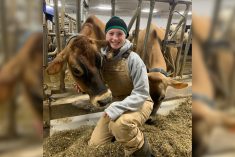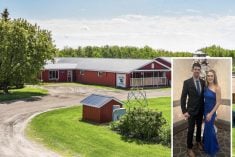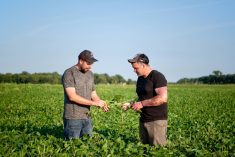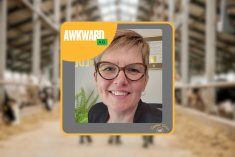I was 22 and I had somehow scraped up enough courage to ask my parents about the possibility of succession. It’s a moment carved in my memory. There I was sitting in the kitchen of the farmhouse with my soon-to-be husband, my Dad and our provincial ag rep.
The ag rep asked what we wanted help with. That’s stuck in my memory too. All we did was shrug. For the first time ever around that boisterous table, we hit a wall of silence.
With all the good intentions in the world, the ag rep started in on a long, complicated explanation about corporations and shares that made our heads spin.
Read Also

Youth focused on keeping Quebec’s dairy industry strong
In part two of our Making the Future series, Country Guide spoke with Béatrice Neveu from Rawdon, Que. (Read part…
For both generations, the fear took over. With hearts in our mouths, the process stopped before it even started. Now 20 years later, how much has agriculture learned?
If Morley Ayars had been sitting at our family’s kitchen table, that would have been a familiar story. As a farm business management specialist for Saskatchewan Agriculture, he’s heard it many times while trying to help families through
a transition. It just isn’t always the transition that the family — or at least some parts of it — is looking for.
Ayars says that when it comes right down to it, much more of his career has been spent on estate planning rather than passing on the farm to the next generation. When it comes right down to it, says Ayars, a farm business management specialist with Saskatchewan Agriculture, much more of his career has been spent on estate planning rather than on passing the farm to the next generation.
In his experience it usually happens like this. An older couple comes into his office for help with a big business decision or change. Perhaps it’s time to replace equipment, or maybe a piece of land has come up for sale, a grandchild has arrived or a spouse is sick.
The conversation soon turns to retirement plans and succession. The couple goes home and they talk about it some more. Then they meet Ayars again to draft a succession plan, and they go on to consult a lawyer and an accountant.
Then they go home and tell each of the children their plan. But they don’t ask what the kids want or hope for.
“Many advisers, including some accountants and lawyers, get the cart before the horse in the succession process, resulting in failure,” agrees Jim Snyder, national ag director at BDO Canada. “The rural grapevine works very well and these failures are contributing to the current inertia.”
About a decade ago, a young extension specialist created a checklist to help farm families through the succession process (read it at www.omafra.gov.on.ca/english/busdev/facts/10-025.htm). Peter Coughler from OMAFRA says before getting caught in all the details of
formal succession planning, there are four preliminary steps families can take to make it go more smoothly.
Start talking. If you don’t, you probably won’t be successful. Sharing information dispels fear and suspicion — the twin enemies of progress. Besides, once you open the door and listen, people might just surprise you. “The one passing on the farm needs to talk clearly with kids,” agrees Ayars. “Debunk assumptions.”
A mistake Ayars has seen is to go from no one communicating to jumping into a family meeting about succession. “Often it turns into a free-for-all,” he says.
“The strongest bonds between generations are when they can talk freely about each others’ strengths and weaknesses,” says Ayars. “Especially when the older generation can admit weaknesses.”
He suggests taking some baby steps first. Talk to each child individually about your wishes and explain your reasoning. “If you don’t do this when you’re alive, the inheriting farmer must deal with it.”
Basically with a farm estate only two things can happen — the non-farming children get less or nothing, or the farm assets are split up equally. ” Either way someone gets hurt and there can be jealousy between siblings,” says Ayars.
Whole-family council meetings are another way to talk about estate and other family issues. This is a good time to explain the difference between family, business and ownership and where everyone’s influence falls.
A family meeting might be a great place to address the issue of fair (equitable) versus equal division of the farm. However, do it early in the process, especially if off-farm family members are involved.
Some farm families are excellent at involving their spouses and children from a young age in the decision making. Meeting to discuss pros and cons is a natural part of the business. For others, an objective, third-party facilitator can help the process run smoothly, so everyone has an opportunity to voice their concerns.
Once you’re communicating better, the founders and the next generation need to spend some time thinking about their own separate goals and expectations. Write down some personal, family and business goals, and then be prepared to share them.
Take time to really listen to everyone’s responses and don’t assume you’re going to know how everyone is going to answer these questions. “Many families are very surprised to discover the very people that they work with every day have very different views,” says Snyder. “This creates situations where co-workers keep their heads down and their mouths shut, in the interest of keeping peace in the family.”
“The soft stuff is the hard stuff,” says Snyder. Again, the help of a third-party facilitator may help.
Step 3. Identify the successor(s)
Just because a son or daughter wants to take over the farm doesn’t mean they have the skills or aptitudes to do it.
It’s a question that has to come to surface during some sort of evaluation process. “Test for and train, if necessary,” says Snyder.
Before selecting a successor, think about the skills the person will need in order to manage the farm in the future. Writing those skills down takes some of the subjectiveness out of the discussion, and some of the emotion too.
It can also help you visualize what the farm will look like in the future, and it may even inspire you to make sure you do everything you can to give the farm the best possible leg up.
“If you’ve been working with someone for a while, you likely have a good sense of that person’s strengths and weaknesses,” says Ayars. If a child has been a labourer for 20 years and has never asked you about your decisions, for instance, are they going to be successful? What skills will need to be developed?
If you’ve got more than one person interested in the farm, a trained adviser can help evaluate skills and aptitudes in terms of the business. “It’s not necessarily a copy of you that will make the best successor,” says Ayars.
If no potential successors can be identified, the discussions can turn to wealth preservation, transitioning out of farming and estate planning
Step 4. Make your goals compatible
Once the successor is identified, Coughler says, it’s time to go back to the objectives and goals to see if you can make them fit together. They don’t have to be the same but they do have to be compatible.
Be forewarned. If your objectives and the family’s objectives are miles apart, you may need to create a strategy to reach consensus. That doesn’t mean it’s impossible but it does mean that the process might require more time, and also require more flexibility and openness from both generations.
Snyder calls this “determining common interest.” It’s also been called facing reality.
Real numbers can help create a framework for discussion. Start by knowing how much money Mom and Dad need for retirement. Then ask how much the successors can afford to pay. Most farm transfers are not based on market value but on repayment ability.
Track living expenses minus non-farm income for a year and then add in any foreseeable changes. Once you get over the shock, you’ll get a good estimate of what both parties are going to need from the farm.
While you’re at it, write down non-farm assets, life insurance policies, who owns what, business structures, debt sources, and farm values, now and when you purchased it. This will help you get a broad picture of your farm’s financial situation.
Remember, senior citizens frequently live 30 or more years after retirement, so don’t neglect the effects of inflation on asset values and living costs. The older generation may need the money from the sale of farm assets to live off of as they age. “Protect yourselves first,” says Ayars.
Profitability can be the show-stopper when it comes to developing a succession plan. Share the financial information about the farm. Saskatchewan Agriculture’s booklet called Estate Planning Checklist for Farm Families, (you can download it at www.agriculture.gov.sk.ca) recommends you be prepared to share financial statements and tax returns with family or advisers.
Many ag extension websites have helpful financial and production benchmarks for evaluating the competitiveness of the farm and the potential opportunity for gains. The Ohio State extension website has a spreadsheet ( www.ohioline.osu.edu) with 16 different financial ratios and their desirable ranges.
Succession planning is simply a part of human resource management and a natural next step for any growing business. It minimizes risk, removes uncertainty and creates a pathway for future development.
For a farm to keep going, the current generation must have an exit strategy and a plan for transitioning responsibilities to the next generation.
Giving yourself a timeline for this process will help stop procrastination. By the time the succession details are worked out and training started, it will likely take a minimum of three to five years.
“The most important thing is to keep the family together,” says Ayars. “You don’t want to leave a heritage of disunity and discord.”CG
———
“ It isn’t necessarily a copy of you that will make the best successor.”
— Morley Ayars














